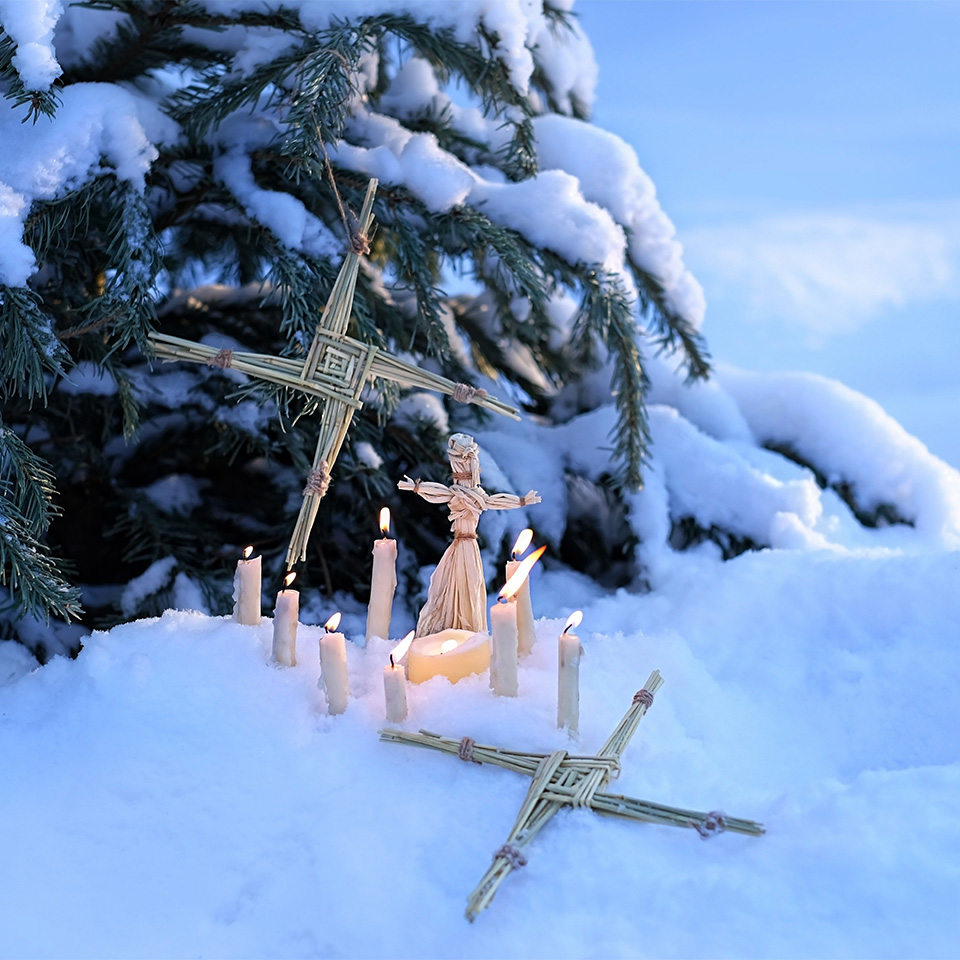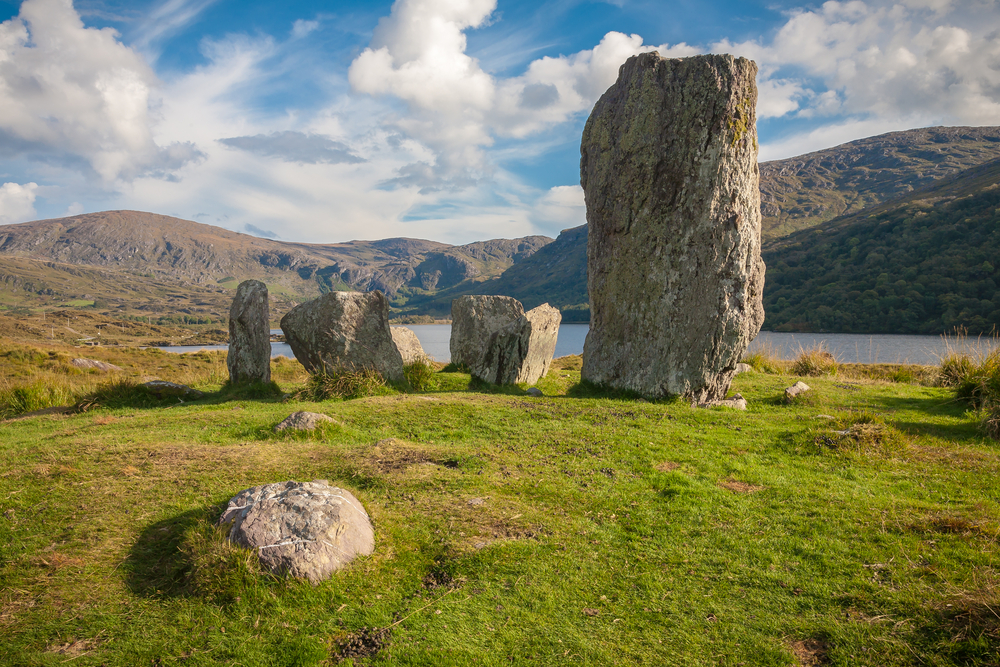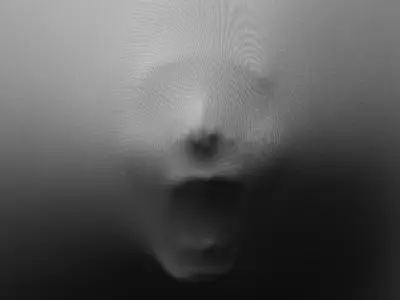Irish mythology is a unique and fascinating subject. It consists of four cycles (Mythological, Ulster, Fenian, and Kings’ Cycle) and also draws upon folklore and pagan traditions, with some elements even being integrated into certain Christian doctrines. The pantheon of Irish deities and the plethora of stories that were passed down throughout history are vast, but some are certainly more well-known than others. In this blog, we’ve picked out some of our favourites.
Jump to:

The Cattle Raid of Cooley (Táin Bó Cúailnge)
The Cattle Raid of Cooley, also known as Táin Bó Cúailnge, is one of the central stories of Irish mythology. It revolves around the conflict that breaks out between Queen Medb of Connacht and the hero Cú Chulainn of Ulster over a prized bull called the Donn Cuailnge.
Queen Medb desired the Donn Cuailnge to match the wealth and status of her husband, Ailill, who possessed a slightly-less-famous white-horned bull named Finnbhennach. However, the Donn Cuailnge belonged to Dáire mac Fiachna, a nobleman in Ulster. Ignoring a prophecy that foretold impending doom, Medb gathered a massive army, including warriors from all over Ireland, and launched an invasion of Ulster to seize the bull.
The Ulster warriors laboured under a curse that left them debilitated, except for Cú Chulainn, a young champion who single-handedly defended Ulster against Medb's forces. Cú Chulainn's extraordinary strength, battle skills, and magical abilities made him a formidable opponent, and he vanquished Medb's champions (including his own foster-brother, Ferdiad, in a 3-day single combat). He also faced supernatural challenges like the shape-shifting sorceress, Morrigan.
The epic battle between Cú Chulainn and his enemies raged until the former was wounded too severely to continue, and the Donn Cuailnge was captured by Medb's forces. However, this does not end the tale, as Cú Chulainn rallied his remaining strength, and was finally joined by the rest of the recovering men of Ulster. Eventually, the Donn Cuailnge was brought back to Connacht, where it fought and killed Ailill’s white-horned Finnbhennach, and a truce was forged.
The Myth of Cú Chulainn
The Myth of Cú Chulainn also exists outside of The Cattle Raid of Cooley, further portraying his remarkable feats, tragic destiny, and his role in defending Ulster against its enemies.
Cú Chulainn, also known as Setanta, was the son of Lugh, the god of light, and Deichtine, sister of the king of Ulster. As a child, he was blessed with extraordinary strength and skill, earning the admiration of many. In some legends, his abilities were further enhanced by the gift of seven toes on each foot, seven fingers on each hand, and seven pupils in each eye.
Throughout the Cattle Raid of Cooley, Cú Chulainn exhibits incredible martial prowess, often entering a battle frenzy called the "ríastrad" in which he no longer recognises friend from foe. In this state, his physical abilities were enhanced still more, allowing him to defeat rival champions and supernatural creatures alike.
However, Cú Chulainn's story was also marked by tragedy. He fell in love with and married Emer (although he had many other lovers) but, to prove his worthiness, he underwent various trials and battles. He also experienced numerous personal challenges and conflicts, at one point even killing Connla, his own son, during a combat in which the latter was bound by oath to hide his identity from his father.
Ultimately, Cú Chulainn met a premature end at the age of 27, when he was tricked into facing overwhelming odds during the final battle of the Táin. Mortally wounded, he lashed himself to a standing stone, ensuring that he died on his feet, still determinedly facing his enemies.
The Children of Lir
The Children of Lir is a tale of sorrow, endurance, and the longing for freedom, and serves as the basis for the classical ballet “Swan Lake”. The story begins with King Lir, who married a woman named Eva. The blissful couple had four children: Fionnuala, Aodh, Fiachra, and Conn.
When the children were still young, their mother died, leading King Lir to remarry and take an enchantress, Aoife, as his new wife. However, Aoife became jealous of the love that King Lir had for her stepchildren. Knowing that commiting murder would cause the children’s ghosts to haunt her forever, Aoife instead took the children to a lake and used her magic to transform them into beautiful swans. They were destined to spend 900 years as swans, with the first 300 years being spent on Lake Derravaragh, the next 300 on the Sea of Moyle, and the final 300 on the Isle of Inish Glora.
Despite being trapped in swan form, each child maintained their human voice and ability to sing, which brought great solace to those who heard them. Over the centuries, they met several individuals who showed them kindness and compassion, including saints and warriors. They were also reunited with their father, who banished Aoife as soon as he learned what she had done to them. However, they were still unable to revert their transformed state, as Aoife’s spell could only be broken when a bell tolled to herald the arrival of St. Patrick.
Eventually, and following the death of King Lir, Christianity reached Ireland, and a monk named Mochua learned about the Children of Lir. He visited them on the Isle of Inish Glora, and blessed them. At his touch, the swans' feathers fell away, revealing the four children, now all ancient men and women. Realising that their remaining time was short, Fionnuala arranged a Christian burial for her and her siblings, and they were able to die in peace.
The Fianna
The Fianna were a legendary band of warriors. Led by the hero Fionn mac Cumhaill (also known as Finn McCool), the Fianna were renowned for their bravery and skills in battle. The Fianna were also associated with their own code of honour, known as the "Fian Code", which emphasised loyalty, courage, generosity, and respect for nature.
Fionn mac Cumhaill was the son of Cumhaill, the former leader of the Fianna. After his father's death, Fionn assumed leadership of the group. The Fianna defended the High King of Ireland and protected the land, and many stories were told about them that were filled with adventures, heroic deeds, and mythical creatures. They regularly engaged in battles against rival warriors and supernatural foes, routinely displaying remarkable combat skills.
Despite their valour, some accounts claim that the Fianna were disbanded due to conflicts and political upheavals in Ireland. Later tales also downgraded their heroic status somewhat, instead presenting them as the household troops of the High Kings of Ireland.

The Salmon of Knowledge (Bradán Feasa)
The Salmon of Knowledge, also known as Bradán Feasa, represents the pursuit of wisdom and the importance of knowledge. It showcases the idea that wisdom can be attained through many means… including those that are unexpected! In fact, the Salmon of Wisdom itself was only imbued with the world’s knowledge by virtue of accidentally eating nine hazelnuts that fell into the Well of Wisdom from nearby trees.
According to the legend, a poet and druid named Finegas desired wisdom and insight. He sought out the Salmon of Knowledge, said to dwell in the River Boyne. Due to its chance meal at the Well of Wisdom, the salmon was known for its ability to grant knowledge to anyone who consumed it.
After 7 long years, Finegas caught the elusive salmon and entrusted its cooking to his protege, the young Fionn mac Cumhaill. He instructed him not to eat any of the fish right away, but instead to cook it and bring it to him when it was ready. However, fate was not on the side of Finegas! While cooking the salmon, Fionn accidentally burned his thumb and unthinkingly put it into his mouth to soothe the pain. Immediately, he unwittingly acquired the salmon's knowledge and wisdom.
The legend continues by recounting Fionn's subsequent rise, telling how he became a renowned hero and leader of the Fianna. His newfound wisdom and knowledge allowed him to not only make wise decisions, but also solve problems and outwit his enemies. Indeed, it was thanks to the Salmon of Knowledge that Fionn devised the seven tests by which new members of the Fianna were selected, making sure that none but the most skilled would join their ranks.
The Banshee
The Banshee was a female spirit or fairy who foretold death by wailing or keening. She was often depicted as a veiled woman or an old hag, dressed in white or grey garments and having long, dishevelled hair. Known as the bean sídhe, which means "woman of the fairy mound", her eerie cries were said to herald a family member's demise.
The wailing of the Banshee was considered to be a forewarning or an omen of an impending death in the family she was connected to. It was believed that her cries were particularly audible to those who were closely related to the person who was about to pass away. The Banshee's mournful wails were said to evoke a sense of sorrow and impending loss.
While her presence was generally associated with impending doom, the Banshee was not considered to be malevolent or harmful in of herself. Instead, she was seen as a supernatural entity that was merely fulfilling her duty as a messenger of the Otherworld, warning and mourning the departed.
The Legend of Tir na nÓg
The Legend of Tir na nÓg, which translates to "Land of Eternal Youth", told the story of a magical land where time passed differently. Those who entered it were said to never age or suffer from illness. Years or even centuries could pass in Tir na nÓg while only a short time would elapse in the human realm.
In the legend, Tir na nÓg was described as a realm of extraordinary beauty and abundance, being located across the sea or beneath the waves. It was inhabited by the Tuatha Dé Danann, a mythical race of gods and goddesses.
Tir na nÓg was said to be accessible to mortals through various means, such as by sailing westward or by encountering a supernatural being who could guide them there. Tales of Tir na nÓg often involved romance, as mortals would fall in love with residents of the land and decide to stay. However, those who left Tir na nÓg and returned to the mortal world often found that a significant amount of time had passed, and they no longer fit in with society.
The Morrigan
Mentioned in the Cattle Raid of Cooley, the Morrigan was a complex figure, embodying both positive and negative qualities. While she brought destruction and chaos, she also had the potential to inspire bravery, protect the land, and guide individuals towards their destinies.
The Morrigan was often depicted as a goddess who took the form of a crow or raven. She was known to appear before battles, predicting (or even shaping and influencing) their outcomes, or inspiring bravery and renewed ferocity in warriors who beheld her. Her presence was believed to be an omen, foretelling victory or defeat.
Alternatively, the Morrigan was sometimes depicted as a triune goddess, appearing as three distinct figures: Badb, Macha, and Nemain. Each aspect represented different facets of her power and influence. As Badb, she was associated with the fury of battle, often appearing as a crow on the battlefield that inspired fear and chaos. As Macha, she represented sovereignty, embodying the power and authority of the land and its rulers. As Nemain, she personified the frenzied madness and terror of war.
The many Irish myths, legends and tales were passed down over thousands of years, and we could still be writing this time next year if we were to try and detail everything that this rich culture has to offer! That’s why we created our Irish Mythology Diploma Course, available now for just £29 (save £98!). If you’re interested in Ireland and its literature, or simply enjoy learning about myths and legends, then this course is the overview you’ve been looking for!




